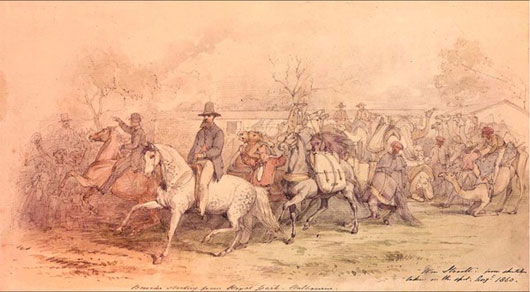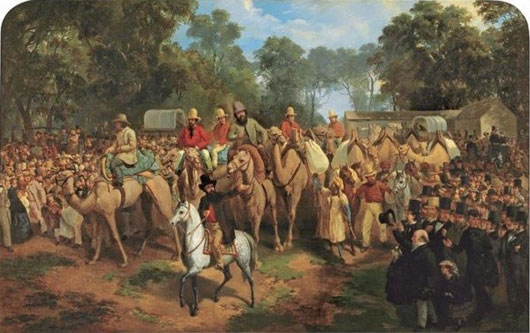The tragic outcome of the
To be able to draw a map for Australia, many adventurers had to trade with their own lives.
Unlike other continents, Australia is a place with extremely harsh terrain, many deserts with scary weather. Therefore, many people did not dare to explore this continent at first.
It took until 1861 to have the first brave people come to explore, discover this place, but in the end, they had to pay with their own lives .
The adventure is promising
Initially when Europeans discovered Australia, they considered it a land of death - a place with long desert, harsh weather, extremely scarce food. Therefore, for a long time, European countries "used" Australia as a place to detain and exile prisoners.
But the discovery of gold in Victoria in 1851 changed everything. Many people migrated here more, and in 1860, the continent had nearly 140,000 people.

The original expedition had 19 people
However, the need to expand inland land is still an impossible task. Therefore, in 1857, Victoria authorities set up a committee to find brave people who dare to explore and reclaim new lands.
In that list, there is Robert Burke - a retired soldier and Dr. William Wills. After a long time of preparation, the expedition decided to depart in August 1860.

At that time the group consisted of 19 brave men of different nationalities, who used 23 horses, 6 cars and 26 camels to travel across the continent of Australia.
On the day of departure, there were more than 15,000 people coming to see them, all hoping the expedition would open a promising new page for Australia. However, few people suspect that this trip will accidentally bring many people to hell.
Wrong decisions
In July 1859, the South Australian government put a grand prize for anyone who reached longitude 143 in the northern part of the continent. An explorer named John Stuart Mill declared loudly, no one could do this except him. This statement made the expedition angry and everyone tried to find a way to win.
This difficult journey lasts for several days. In the land of Gambala, to limit the strength of the animals, Burke and his colleagues went on foot to minimize the weight of horses and camels.
The expedition was more difficult and arduous when in two consecutive months, the delegation went to 750km. From here, many people in the delegation seemed depressed. Thirteen members of the expedition decided to give up but fortunately, Burke and Wills also found 8 new people to replace.

Burke, Wills, Gray and King split the group to explore the North
Slow and slow speed makes Burke very impatient, he decides to split the expedition to be able to move faster, increasing the chances of winning John. His plan was to choose the strongest horse with seven agile men and a certain amount of equipment to go to the Copper Creek River to explore first. After that, they will wait for others to catch up.
But a conflict occurs when people come to this riverside area. While many people want to wait 1-2 months to pass the heat wave, Bruke wants to move immediately. The expedition was split again, Burke, Wills and two other members, Gray and King, set out, leaving several people managed by the Brahe members to guard the camp.

This is a very wrong decision of Burke, the outdoor temperature is now very high, nearly 50 degrees Celsius. Although many new lands have been acquired, strange and unique trees, but the extreme weather has caused for the whole team very tired.
A camel was left, three other camels were killed for food on the way. Blacker, Gray got dysentery, he was very tired but Burke said that this was just a lazy game so he continued to order the group to move.
Gray poorly exhausted and died on April 17, 1861. Too grief-stricken as well as realizing that food was depleted, Burke and Wills decided to return to Cooper Creek. After a few days of hard work, the three of them finally arrived at Cooper Creek but were horrified to realize that the whole camp here had no more people.
Unfortunate adventurers
The reason is that while Burke was separated, one of the men was seriously ill and died. Things made Brahe extremely depressed. Besides, before leaving, Burke had promised to return within 13 weeks, but wait until the 18th week, Brahe's group still did not see anyone.
Therefore, Brahe decided to return to get more food at noon on April 21, 1861. Black, only a dozen hours later, Burke, Wills and King arrived at the camp.

Burke, Wills and King were extremely desperate to learn they were abandoned
The three are extremely tired, hungry, and the food Brahe leaves is not much. Without waiting, Burke decided to go with Wills and King to move south to seek help. Before leaving, they leave a letter in the inventory and a diary of their journey at the camp for Brahe if he returns. As expected, Brahe returned to the camp on May 8, but he could not find the letter.
Burke, Wills, King helplessly move, the more they go, the more desperate they are, the lack of water, food, and the exhausted body due to extreme weather. Wills and Burke died in July 1861, while King was fortunate to be saved by Aboriginal people.

The expedition mapped many important places in the interior of Australia
On September 15, the royal rescue team found King. He just cried and recounted the arduous journey and the things they had to endure. From his account, it was known that Burke and Wills left valuable documents in the camp on Cooper Creek.
Great discoveries
With each move, Burke, Wills, Gray redrawed Australia's important geographic locations. More specifically, they have perfected the lands in the north, naming large rivers and streams people do not know.
A rescue team was sent to search Burke's body with Wills. On the way, they also discovered countless landmarks and important geographical knowledge. Burke and Wills's bodies were then buried and buried carefully in Melbourne Cemetery in the mourning of 40,000 attendees.

To commemorate the great merits, images of Burke and Wills have appeared on many items of the Australian people
More interestingly, there was a doctor - a plant researcher named Hermann Beckler. During this trip, Beckler collected more than 45 completely new plants. Thanks to Beckler's work, modern science knows exotic plants in Australia.
- Both the liver teased the tiger, Dogo received a tragic outcome
- 28 mysterious remains reveal the disaster from the game of children
- Baby elephants stray into good prey for lions
- 7 most tragic events in human history
- The tragic life of dwarves locked up in the zoo in New York
- Looking for the most tragic queen's tomb in Egypt: Must marry her grandfather, father and brother
- Fear for rabbits before Tet
- 6 strange tactics create unexpected victories in the history of war
- Asia: Discrimination must be eliminated with HIV infected people!
- What happens if you fall into a liquid nitrogen tank?
- Tigers carry a warring god with civets and tragic deaths
- Welding teeth many times will make you get an extremely frightening outcome
 'Fine laughs' - Scary and painful torture in ancient times
'Fine laughs' - Scary and painful torture in ancient times The sequence of numbers 142857 of the Egyptian pyramids is known as the strangest number in the world - Why?
The sequence of numbers 142857 of the Egyptian pyramids is known as the strangest number in the world - Why? History of the iron
History of the iron What is alum?
What is alum?